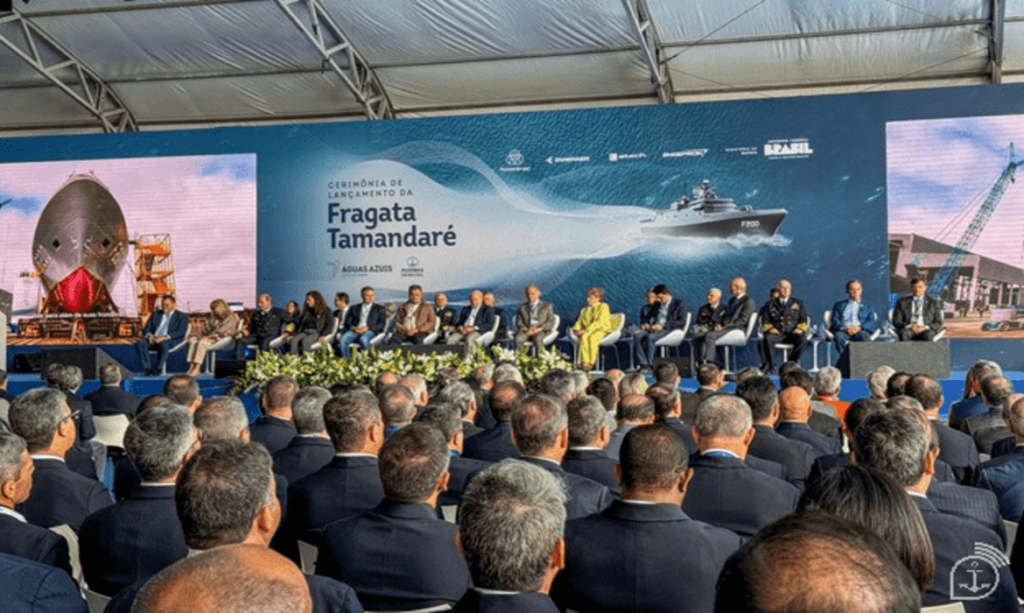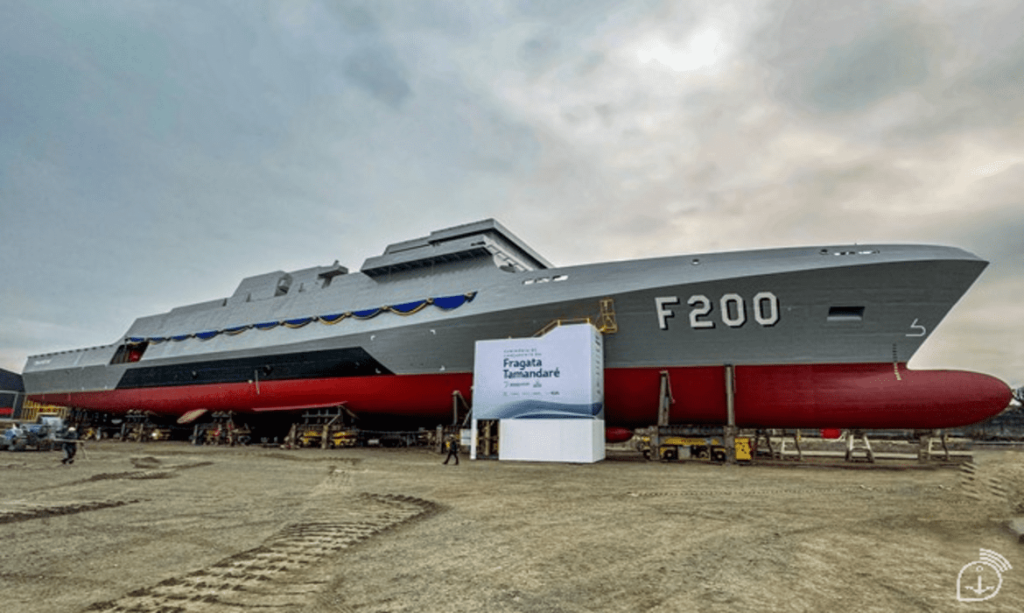Brazilian Navy Launches First Tamandaré Class Frigate
On Friday, 9 August, the Brazilian Navy [MB] launched the frigate “Tamandaré (F200)”, based on the German MEKO A-100. This development, which represents an essential milestone in Rio’s long-term “Naval Modernisation Programme”, was celebrated with a ceremony at the shipyard of ThyssenKrupp Estaleiro Brasil Sul (tkEBS), the Brazilian subsidiary of Germany-based ThyssenKrupp Marine Systems (TKMS), in Santa Catarina, Itajaí. The event was attended by many political, military and industry dignitaries, including President Luís Inácio Lula da Silva, Minister of Defence José Mucio Monteiro, and Chief of Naval Staff Admiral Marcos Sampaio Olsen.
Tamandaré is the first of four frigates being built under the Tamandaré Class Frigate Programme (PFCT), launched in 2017 to replace the Niteroi class frigates (based on the British Type 21 design) that have served in the Brazilian navy for many years. The PFTC, Brazil’s most innovative shipbuilding project to date, is managed by the state-controlled Empresa Gerencial de Projetos Navais (EMGEPRON), and the construction activities are the responsibility of the Águas Azuis Consortium [comprising ThyssenKrupp Marine Systems, Embraer Defence and Security and Atech].
Speaking during the ceremony, Brazilian Defence Minister José Múcio Monteiro Filho said that he was pleased to see the results of the initiatives of different sectors of Brazilian society, adding:
“There is no better proof of our capacity in defence than the delivery of the Tamandaré Class Frigates. This will enable the replacement of ships that have been in operation for over 40 years. This will realise the urgent renewal of our Fleet. This need to make the Navy better able to defend Brazil’s interests at sea coincides with the confirmation of the enormous riches in the Blue Amazon that must be protected for the Brazilian people.”
Brazilian President Luís Inácio Lula da Silva said: “The technological modernization of our Armed Forces and the strengthening of its Defense Industrial Base is a strategic initiative from the most diverse points of view: defense, economy, technology and international cooperation.” He added that “this project, which brings together cutting-edge technology, is the result of a very well-built partnership between the Ministry of Defense and the Brazilian Navy with the Águas Azuis consortium.”

According to the delivery schedule planned by SPE Águas Azuis, Tamandaré, the leading ship of its class, will enter the service of the Brazilian Navy in 2025 after sea trials. The second Tamandaré class frigate, “Jerônimo de Albuquerque” (F-201), whose keel was laid in June 2024, will be delivered to the MB in 2027. The third and fourth frigates of the project, “Cunha Moreira” and “Mariz e Barros”, are expected to be ready between 2028 and 2029.
The frigates will be equipped with advanced radars, sensors, and state-of-the-art weaponry and, once ready for service, will primarily help protect Brazil’s vast maritime area, covering more than 5.7 million square kilometres, known as the ‘Blue Amazon’. They will also be used to conduct search and rescue operations, monitor and combat piracy and illegal fishing, and fulfil international commitments.
Technical information of the Frigate Tamandaré:
- Length: 107.2m
- Beam: 15.95m
- Depth (height): 20.2m
- Displacement: 3,380 tons
- Range: 5,500 nautical Speed: 25 knots (equivalent to approximately 47 km/h)
- Crew: 130
- Helicopters: can carry two naval helicopters, one in the hangar and one on the platform.
In addition to the PFCT, Brazil has several other programmes focusing on different naval platforms, weapon systems, and equipment. These projects are as follows: the Submarine Development Programme (PROSUB), the Patrol Vessels Procurement Programme (PRONAPA), the hydrographic vessel (PROHIDRO), anti-ship missiles (MANSUP), and vehicles and equipment for the Marine Corps (PROASDUMUS). Some of these have already started, while others are still awaiting funding.

